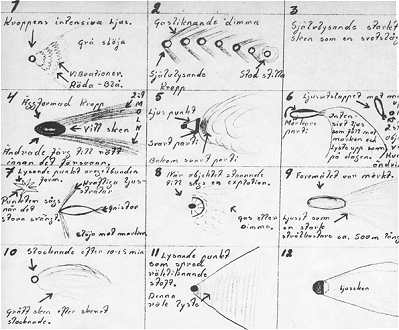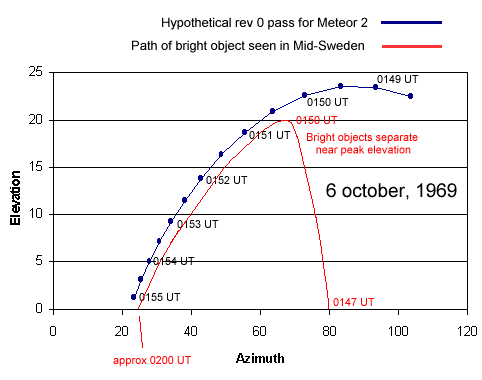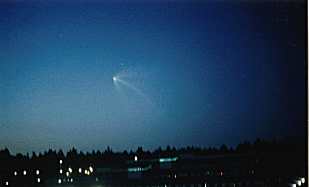 Visual
observations of launches from Plesetsk
Visual
observations of launches from Plesetsk Visual
observations of launches from Plesetsk
Visual
observations of launches from Plesetsk
These observations were widely reported in the local and national press here in Sweden , and in early November 1969 I was contacted by UFO groups who wanted to check if this was a satellite launch, which they suspected. At the time I quickly identified this object as being the launch vehicle of Meteor 2 launched from Plesetsk.
 I
was able to reconstruct the motion of the bright object across the sky,
mainly because of a very accurate observation made by two police officers
in the village Kramfors. They said the bright object reached an elevation
slightly below the star Mizar, which happened to be about 31 degrees above
the horizon. The meteorologist at the airport of Sundsvall also gave the
maximum elevation as 25 degrees. The time of disappearance of the object
is a bit unclear, probably because a smoke cloud remained visible
for quite some time.
I
was able to reconstruct the motion of the bright object across the sky,
mainly because of a very accurate observation made by two police officers
in the village Kramfors. They said the bright object reached an elevation
slightly below the star Mizar, which happened to be about 31 degrees above
the horizon. The meteorologist at the airport of Sundsvall also gave the
maximum elevation as 25 degrees. The time of disappearance of the object
is a bit unclear, probably because a smoke cloud remained visible
for quite some time.
I have plotted my interpretation of the path of the bright object across the sky together with a hypothetical orbital path of Meteor 2 back-tracked to the zero-th orbit. This graph shows that the bright object quickly approached the path of Meteor 2. Therefore, it seems that the Vostok booster used a direct ascent, i.e. it made a steep ascent directly to orbital height instead of entering an elliptical parking orbit and entering final orbit on the opposite side of the earth.
The reason for the observations of Meteor 2 must be sought in the fact that the exhaust plume was in sunlight, while all the observers were in darkness. This conditions was not always satisfied for these launches from Plesetsk.
I am deeply indebted to Mr. Björn Högman of the now-defunct Gothenburg Information Center for Unidentified Flying Objects (GICOFF) for providing me with all the observational material concerning the observations of the launch of Meteor 2 and for making the sketch at the top of the page. Normally, I am skeptical to UFO groups and their methods, but I must admit that Mr. Högman and GICOFF as I knew them in the late 60's were committed to rigorous scientific method in their analysis of observations. They did provide me with many interesting observations, including that of the intercept of Kosmos-459 by Kosmos-462.
 Observations
of Meteor 13
Observations
of Meteor 13The all-sky camera at the Kiruna Geophysical Observatory (nowadays the Swedish Institute of Space Physics) recorded the launch on 16 mm film with one frame every minute. The large plume (the size of the Moon) can first be seen in the picture taken at 2209 UT at 20o elevation and 48o azimuth (see strip of pictures on the right). Three minutes later the elevation was 11o and the azimuth 31o. In the picture at 2213 UT the plume is barely visible, while a very bright spot appears in the following image. The absence of a bright spot at 2213 UT may represent a brief period of coasting and the bright spot that appeared at 2214 UT is the third stage burning.
I am indebted to Mr. Torbjörn
Löfgren of the Swedish Institute of Space Physics for providing these
pictures. For those who wish to understand how an all-sky
camera works the institute provides a description.
 A
very good picture of a launch from Plesetsk was taken at the time of launch
of Meteor 2-7 which took place on 15 May 1981 at about 2150 UT. The satellite
achieved an orbit at 835 - 888 km at an inclination of 81.3 degrees.
A
very good picture of a launch from Plesetsk was taken at the time of launch
of Meteor 2-7 which took place on 15 May 1981 at about 2150 UT. The satellite
achieved an orbit at 835 - 888 km at an inclination of 81.3 degrees.
The picture on the left was taken by Susanne Hultman, a student at the University of Umeå in Northern Sweden, while her group of astronomy students gathered at the roof of the university building. The slight blurring is caused by the 0.5-second exposure time.
I got this picture from her
instructor Dr Stig Lindgren. Click here
for Susanne's own website (in Swedish).